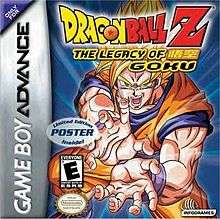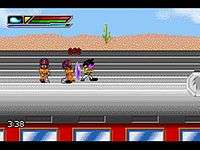Dragon Ball Z: The Legacy of Goku (series)
| Dragon Ball Z: The Legacy of Goku | |
|---|---|
 Cover art for the first Legacy of Goku game for the Game Boy Advance | |
| Genres | Action role-playing |
| Developers | Webfoot Technologies |
| Publishers |
Infogrames (Legacy of Goku and Legacy of Goku II Europe) Infogrames (Under the Atari brand name) (Legacy of Goku II North America) Atari (Buu's Fury) Banpresto (The Legacy of Goku II International Japan) |
| Creators |
Dana Dominiak (The Legacy of Goku) Murray Kraft (The Legacy of Goku II) Debra Osborn (Buu's Fury) |
| Artists | Mandi Paugh (characters) |
| Writers | Gerry Swanson (The Legacy of Goku II and Buu's Fury) |
| Composers |
Ariel Gross (The Legacy of Goku) Yannis Brown (The Legacy of Goku II and Buu's Fury) |
| Platforms | Game Boy Advance |
| Year of inception | 2002 |
| First release |
Dragon Ball Z: The Legacy of Goku May 14, 2002 |
| Latest release |
Dragon Ball Z: Buu's Fury September 14, 2004 |
Dragon Ball Z: The Legacy of Goku is a series of video games for the Game Boy Advance, based on the popular anime series Dragon Ball Z. All three games are action role-playing games. The first game, Dragon Ball Z: The Legacy of Goku was developed by Webfoot Technologies and released in 2002. The game was followed by two sequels: Dragon Ball Z: The Legacy of Goku II released in 2003, and Dragon Ball Z: Buu's Fury released in 2004.
Gameplay

The games are action adventure RPGs. The player controls a Dragon Ball character and experiences various portions of the franchise. Combat is the main focus of the game. The player can hit the A button to use physical strikes, while the B button allows the player to unleash a variety of energy based attacks. Energy attacks drain an energy meter that recharges when it is not in use. Energy attacks can be cycled through with the L button, and more energy attacks are learned as the player progresses through the game. Later games in the series featured transformations that made the player character stronger temporarily. By defeating enemies, the player receives experience points, which allow the player character to level up and grow stronger. Later games in the series also feature consumable items that would restore the player character's health or energy, and equipment, which increased the stats of the player character. In Buu's Fury and Legacy of Goku II, the player could also use a device called a scouter to look up the stats of the various characters in the game, as well as basic information about them.
Plot
The Legacy of Goku
Dragon Ball Z: The Legacy of Goku is the first title in the series, and was released in the United States on May 14, and in Europe on October 4, 2002. The game covers the story of Dragon Ball Z up until the destruction of Planet Namek. Goku is the only playable character. Goku travels through different stages, including several locations of the earth and planet Namek, and gains experience not only by defeating enemies but also by completing simple missions. In the final stage Goku transforms into a Super Saiyan in order to defeat Frieza, being this the first introduction to character transformations in the series, which will later be very common in the following games. It is also one of the first GBA games to feature full motion video.
The Legacy of Goku II
Dragon Ball Z: The Legacy of Goku II was released on June 17, 2003. The plot of the game picks up where The Legacy of Goku left off, and continues until the end of the Cell Games Saga when Gohan defeats the evil android Cell. The game introduced several new concepts to the series. The first was transformations, which allowed characters to become temporarily stronger, at the cost of slowly draining their energy. It also introduced the scouter, which allowed players to look up the stats of other characters in the game, as well as basic information about them. The game also introduced charged melee attacks, which allowed characters to unleash a powerful physical strike after a short charging period. The game also allowed characters to further supplement their stats with capsules that were scattered around the game world. Despite being titled "The Legacy of Goku" this game featured the most limited play as Goku.
Due to the game's success, a second version was released titled Dragon Ball Z: The Legacy of Goku II International exclusive to Japan on July 23, 2004. In this version all characters were given new profile images and their names were reverted to their original Japanese. However, Mister Satan still retains his English name "Hercule" on the front of his parade float.
Buu's Fury
Dragon Ball Z: Buu's Fury is the third and final game in the series. It was released on September 14, 2004 in North America. The game focuses on the final parts of the Dragon Ball Z series (season 7), namely the battles with Majin Buu. The game added several new additions to the series. First, the game added equipment, which could be equipped to characters to alter their stats and provide various other benefits. The game also allowed players to allocate their own stat points, of which three were given per level. Also added was the ability to block by holding the R button, and also to energy block by holding the B button while blocking. Using the energy block slowly drains the user's energy gauge. Both techniques greatly decrease the amount of damage that is received from attacks. The game also added various other features such as fusions and the ability to transform into a Super Saiyan 3. Although many features were added, the ability to use charge attacks by holding and releasing the A button was eliminated.
The dialogues used in the English edition of the game are very similar, and sometimes identical, to the ones used in the English dubbed animated series.
Characters
The Legacy of Goku games feature a variety of characters from the Dragon Ball universe for the player to play as. In the first Legacy of Goku, only Goku was playable, however in subsequent games in the series, multiple characters were playable including: Gohan, Goten, Trunks (kid and future), Piccolo, Vegeta, and Hercule. In Buu's Fury, a Fusion concept was implemented that allows certain characters to combine with each other, boosting their stats and changing their appearance. The three available fusion characters in the game are: Gotenks, Gogeta, and a one-time playable Vegito.
| | |||||||||||||||||||||
|---|---|---|---|---|---|---|---|---|---|---|---|---|---|---|---|---|---|---|---|---|---|
| |||||||||||||||||||||
Reception
The Legacy of Goku
| The Legacy of Goku | ||||||||||||||||||||||||||||
|---|---|---|---|---|---|---|---|---|---|---|---|---|---|---|---|---|---|---|---|---|---|---|---|---|---|---|---|---|
| ||||||||||||||||||||||||||||
The Legacy of Goku received "mixed" reviews according to the review aggregation website Metacritic.[1] Despite the mixed reaction, the game sold over 1.22 million copies in the United States.[11]
The Legacy of Goku II
| The Legacy of Goku II | ||||||||||||||||||||||||||||||
|---|---|---|---|---|---|---|---|---|---|---|---|---|---|---|---|---|---|---|---|---|---|---|---|---|---|---|---|---|---|---|
| ||||||||||||||||||||||||||||||
The Legacy of Goku II received "generally favorable reviews" according to Metacritic.[12]
Buu's Fury
| Buu's Fury | ||||||||||||||||||||||||
|---|---|---|---|---|---|---|---|---|---|---|---|---|---|---|---|---|---|---|---|---|---|---|---|---|
| ||||||||||||||||||||||||
Buu's Fury received "mixed" reviews according to Metacritic.[23]
See also
References
- 1 2 "Dragon Ball Z: The Legacy of Goku for Game Boy Advance Reviews". Metacritic. Retrieved June 13, 2014.
- ↑ EGM staff (June 2002). "Dragon Ball Z: The Legacy of Goku". Electronic Gaming Monthly (155): 122.
- ↑ Kato, Matthew (May 2002). "Dragon Ball Z: Legacy of Goku". Game Informer (109): 88. Archived from the original on July 27, 2009. Retrieved June 13, 2014.
- ↑ Fennec Fox (May 14, 2002). "Dragon Ball Z: The Legacy of Goku Review for Game Boy Advance on GamePro.com". GamePro. Archived from the original on January 13, 2005. Retrieved June 14, 2014.
- ↑ Provo, Frank (May 17, 2002). "Dragon Ball Z: The Legacy of Goku Review". GameSpot. Retrieved June 13, 2014.
- ↑ Bui-Quang, Phuong-Mai (July 5, 2002). "GameSpy: Dragon Ball Z: The Legacy of Goku". GameSpy. Archived from the original on October 18, 2006. Retrieved June 14, 2014.
- ↑ Bedigian, Louis (June 3, 2002). "Dragon Ball Z: The Legacy of Goku Review - Game Boy Advance". GameZone. Archived from the original on May 1, 2009. Retrieved June 14, 2014.
- ↑ Harris, Craig (May 10, 2002). "Dragon Ball Z: Legacy of Goku". IGN. Retrieved June 13, 2014.
- ↑ "Dragon Ball Z: The Legacy of Goku". Nintendo Power. 156: 142. May 2002.
- ↑ Concepcion, Miguel (July 12, 2002). "'Dragon Ball Z: The Legacy of Goku' (GBA) Review". X-Play. Archived from the original on August 6, 2002. Retrieved June 14, 2014.
- ↑ http://www.the-magicbox.com/Chart-USPlatinum.shtml
- 1 2 "Dragon Ball Z: The Legacy of Goku II for Game Boy Advance Reviews". Metacritic. Retrieved June 13, 2014.
- ↑ EGM staff (July 2003). "Dragon Ball Z: The Legacy of Goku II". Electronic Gaming Monthly (168): 123.
- ↑ Kato, Matthew (July 2003). "Dragon Ball Z: Legacy of Goku II". Game Informer (123): 122. Archived from the original on July 27, 2009. Retrieved June 13, 2014.
- ↑ Fennec Fox (June 17, 2003). "Dragon Ball Z: The Legacy of Goku II Review for Game Boy Advance on GamePro.com". GamePro. Archived from the original on January 23, 2005. Retrieved June 14, 2014.
- ↑ Provo, Frank (June 17, 2003). "Dragon Ball Z: The Legacy of Goku II Review". GameSpot. Retrieved June 13, 2014.
- ↑ Bedigian, Louis (June 26, 2003). "Dragon Ball Z: Legacy of Goku II - GBA - Review". GameZone. Archived from the original on November 2, 2008. Retrieved June 14, 2014.
- ↑ Harris, Craig (June 17, 2003). "Dragon Ball Z: The Legacy of Goku II". IGN. Retrieved June 13, 2014.
- ↑ "Dragon Ball Z: The Legacy of Goku II". NGC Magazine. November 2003.
- ↑ "Dragon Ball Z: The Legacy of Goku II". Nintendo Power. 170: 146. July–August 2003.
- ↑ Metts, Jonathan (July 12, 2003). "Dragon Ball Z: The Legacy of Goku II". Nintendo World Report. Retrieved June 14, 2014.
- ↑ Kane, Brad (August 7, 2003). "'Dragon Ball Z: The Legacy of Goku II' (GBA) Review". X-Play. Archived from the original on December 11, 2003. Retrieved June 14, 2014.
- 1 2 "Dragon Ball Z: Buu's Fury for Game Boy Advance Reviews". Metacritic. Retrieved June 13, 2014.
- ↑ Juba, Joe (October 2004). "Dragon Ball Z: Buu's Fury". Game Informer (138): 147. Archived from the original on July 27, 2009. Retrieved June 13, 2014.
- ↑ Test Monkey (November 2004). "Dragon Ball Z: Buu's Fury Review for Game Boy Advance on GamePro.com". GamePro: 130. Archived from the original on February 3, 2005. Retrieved June 14, 2014.
- ↑ Tracy, Tim (September 23, 2004). "Dragon Ball Z: Buu's Fury Review". GameSpot. Retrieved June 13, 2014.
- ↑ David, Mike (September 26, 2004). "Dragon Ball Z: BUU's Fury - GBA - Review". GameZone. Archived from the original on March 21, 2009. Retrieved June 14, 2014.
- ↑ Harris, Craig (September 21, 2004). "Dragon Ball Z: Buu's Fury". IGN. Retrieved June 13, 2014.
- ↑ "Dragon Ball Z: Buu's Fury". Nintendo Power. 185: 132. November 2004.
- ↑ Marrow, Mark (October 17, 2004). "Dragon Ball Z: Buu's Fury Review". PALGN. Archived from the original on October 23, 2012. Retrieved June 14, 2014.
External links
- Dragon Ball Z: The Legacy of Goku at MobyGames
- Dragon Ball Z: The Legacy of Goku II at MobyGames
- Dragon Ball Z: Buu's Fury at MobyGames